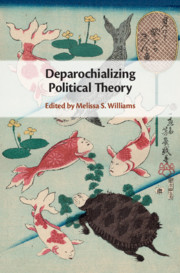Book contents
- Deparochializing Political Theory
- Deparochializing Political Theory
- Copyright page
- Dedication
- Contents
- Tables
- Contributors
- Preface and Acknowledgments
- Note on the Text
- 1 Introduction
- 2 Deparochializing Political Theory and Beyond
- 3 Recentering Political Theory, Revisited
- 4 A Decentralized Republic of Virtue
- 5 Deparochializing Political Theory from the Far Eastern Province
- 6 Is Popular Sovereignty a Useful Myth?
- 7 Authoritarian and Democratic Pathways to Meritocracy in China
- 8 Deparochializing Democratic Theory
- 9 Teaching Comparative Political Thought
- 10 Teaching Philosophy and Political Thought in Southeast Asia
- 11 Why Globalize the Curriculum?
- Index
5 - Deparochializing Political Theory from the Far Eastern Province
Published online by Cambridge University Press: 15 March 2020
- Deparochializing Political Theory
- Deparochializing Political Theory
- Copyright page
- Dedication
- Contents
- Tables
- Contributors
- Preface and Acknowledgments
- Note on the Text
- 1 Introduction
- 2 Deparochializing Political Theory and Beyond
- 3 Recentering Political Theory, Revisited
- 4 A Decentralized Republic of Virtue
- 5 Deparochializing Political Theory from the Far Eastern Province
- 6 Is Popular Sovereignty a Useful Myth?
- 7 Authoritarian and Democratic Pathways to Meritocracy in China
- 8 Deparochializing Democratic Theory
- 9 Teaching Comparative Political Thought
- 10 Teaching Philosophy and Political Thought in Southeast Asia
- 11 Why Globalize the Curriculum?
- Index
Summary
Instead of beginning from intellectual traditions or bodies of thought as the units of analysis in comparative political theory, in this chapter Ken Tsutsumibayashi focuses on the ways in which the meaning of concepts derives from their practical use in particular historical moments. The distinction between “East” and “West,” which still frames so many debates in comparative political theory, dissolves under this contextualizing gaze: from the perspective of Japan as the “far eastern province,” “the West” signified China before it signified Europe. Yet the flow of ideas between Japan and other societies has not always been from West to East. In the late nineteenth century, Japanese thinkers engaged European ideas, and their innovative use of these ideas shaped, in turn, the terms of political discourse in China and Korea, shifting them toward institutions and subjectivities that could be rendered congruent with modernity. The chapter traces the remarkable efflorescence in Japan of innovative constructions of Min (“the people”) in Meiji-period thought, which played a key role in the production of new and “multiple modernities.” Tsutsumibayashi argues that we should relinquish cultural “ownership claims” over ideas; the history of ideas can serve as a common pool resource that can enrich practical reason.
Keywords
- Type
- Chapter
- Information
- Deparochializing Political Theory , pp. 120 - 148Publisher: Cambridge University PressPrint publication year: 2020

